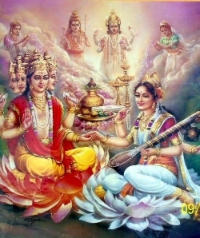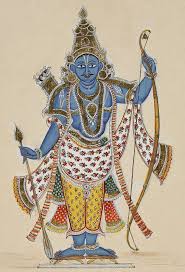Dwadasha stothra 3 : Verse 9
Kaala akala vichara adhi prakalitha sadathanam|
Purusham prakruthim cha vande vishnum ajothamam||9||
Kaala – In samskruta there is a rule that when we are talking about anything Jada (inert), we always refer to abhimani devatha. Eg: Agni does not refer to fire, but to the abhimani devatha that governs Agni.
Similarly when Veda says
- mruda brabith – mud talks – refers to prithivi devathe
- Apo abruvan – water talks – refers to varuna
It can also be alankarika (metamorphic) usage.
While we do tulasi pooje or asana shuddhi we pray to the chetana shakthi inside tulasi and earth.
Kala abhimani devatha – chaturmukha, Durge.
In mahaNarayanopanishad , Chaturmukha is also called as samvatsaraha.
Akala – Prakrithi (sri Tattva), Bhagavantha. One which is timeless/ not bound by time.
Vichara – One which is in constant motion in space and time.
Vaayu is called as sadaGathi because he gives motion to Universe and he himself is in motion constantly.
Kala, akala, vichara are called as shuddha tattvas. That is Lakshmi, brahmavaayuGalu, bharathisaraswathi are shuddha tattvas or Parashuklatraya. These 3 shuddha tattavas are utmost pure ( shuddha sattva) which can be grasped by a human being.
Aadhi – Garuda, shesha , rudra, rshi, gandharvas
prakalitha – To know
The nitya tattva i.e. Bhagavantha is known through these kala, akala, vichara and aadhi.
Another way of looking at it,
- Kaala – Jeevas who are bound by cycle of life and death – samsariGalu – amuktaru
- Akaala – Jeevas who are not bound by cycle of life and death – muktaru
- Vichara – constant remembrance done by amuktaru and muktaru – upasane, dhayana
- Prakalitha – Known by upasane, dhayana etc
In Bhagavad Gita, Krishna says “buddhau sharanam anviccha” – Don’t stop gaining knowledge after gaining little bit knowledge about Lord. Thinking about auspicious qualities of lord should continue after gaining mukthi too.
- before mukthi – sadhane marga – hardship to gain aporaksha jnana.
- After mukthi – siddhi marga – sahaja sthithi – anandamaya
In MahaBharatha, there is a shloka, “Krishno muktaihi ijayatte vitha mohaihi” , that is there is antaranga and bhiranga pooje even in mukthi.
Eg: In moksha, there are many chaturmukhadevaruGalu. One is thinking about rigveda , one is singing gayathri chandas in shakuri raga and contemplating about the meaning that can be derived by this raga, one is thinking about puranas (jatavidya), one is thinking about bhagavat roopas in yagna.
In mukthi one has knowledge about actuality about shastara, but they do not have Jnana about shastara entirely. Only Bhagavantha knows in entirety, not even Brahma Vaayu.
Taittreya Upanishad says after going to moksha, Brahma repeats in samagaana “ha uuuu”.
Ha signifies bhagavantha Roopa that destroys everything – abbreviation of Hari – who removes all sadness. Uuu – supreme Being – Bhagavantha – 2nd letter of omakara
Thus in moksha, there is Veda mantra recitation, shravana, chintana, dhayana, bahiranga pooje by Brahma and devathas.
Upasane gains the highest position in the way of knowing lord. Upasane mainly includes– 1) Learning shastras constantly 2) Meditating upon the knowledge gained by learning shastara
Shravana, manana, niddhidyasa are the initial steps to do upasane, jignyasa, vichara.
Abhyasa – Listening, contemplating
Sadathanam – the nitya tattva that can be known by following above steps.
Another way of looking at it,
- Kala – chaturmukha, rudra( as he destroys), Vaayu
- Akala – Akasha, Veda, Naada, Kala
- Kala – chaturmukha, Vaayu, Yama, rudra
- Akasha abhimani – shiva, parvathi, ganapathi, shesha
- Veda abhimani – Agni is the abhimani for Rigveda, Vaayu is the abhimani for Yajurveda, Chandra and ekarshri agni are the abhimanis for samaveda . Garuda is the abhimani for entirety of vedas.
- Vichara – Vaayu
The one who destroys all these tattvas and is not itself bound by life and death – Bhagavantha
Purusham – purusha sooktha pratipadya – Vishnu – according to veda
According to Vedas there are 3 types of purusha.
- Kshara purusha – The Jeevas who here inside perishable bodies
- Akshara purusha – Sri Tattva – One who doesn’t have perishable body
- Purushottama – One who controls both these kinds of purusha
Uttama purusha is also of three kinds –
- Before creation – Purusaha – One who occupies whole universe during pralaya
- Upon creation of Brahmanda – one who creates Brahmanda and stays inside the Brahmanda
- Upon creation of pindanda – One who stays inside each Jeeva as Bimba Roopa.
Even Brahma who is abhimani of Kaala (time); Jeeva, doesn’t have full knowledge about the Bimba Roopa inside each Jeeva.
Ajothamam- Who is greater than Brahma too. Aja – the first born



